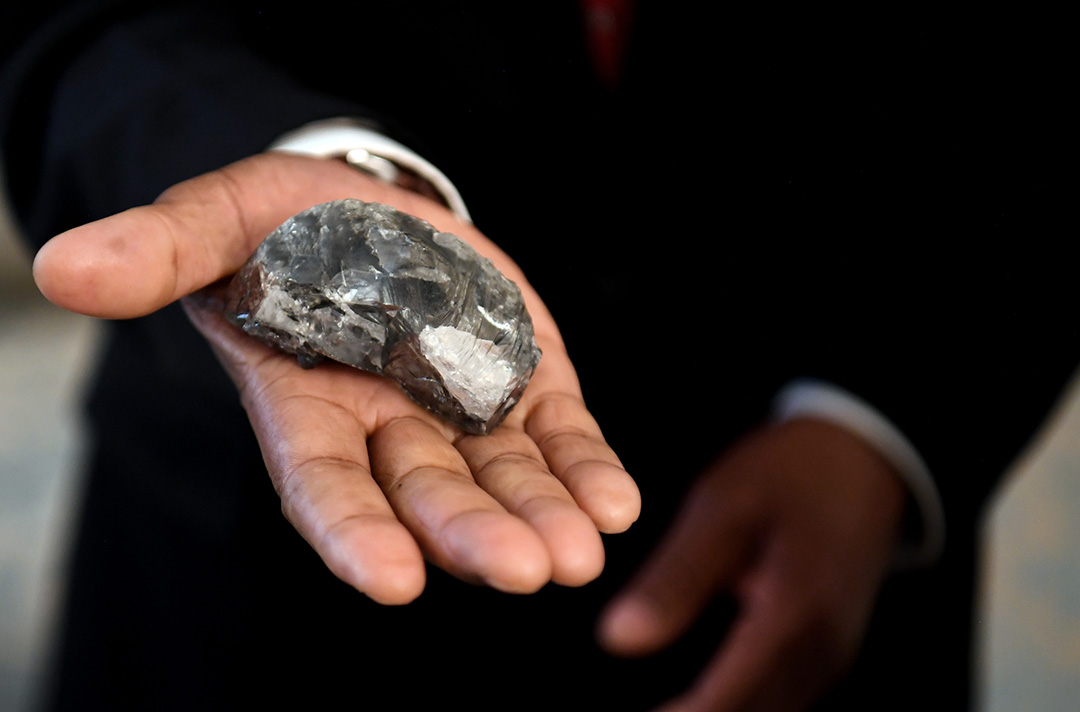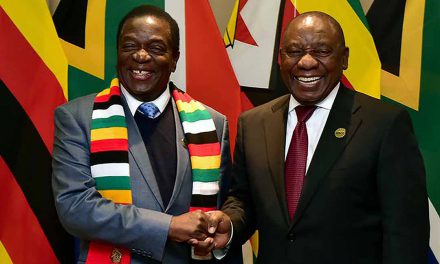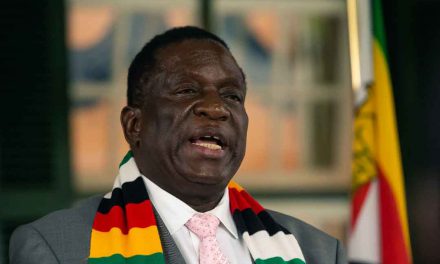By Michael Oabona Kgengwenyane
A review of the paper by Sheila Khama titled “Joint Venture Agreement – Inside the companies that operationalise agreements between Botswana and De Beers – Outlived their value or future Icons?”.
Sheila’s paper comes at the right time on the back of the recently concluded sales agreement between the Botswana Government and De Beers. The negotiations had taken a few years and appeared to have been a bruising affair, especially for De Beers, judging by the years it took to negotiate. The President of Botswana (Mokgweetsi Masisi), in his public addresses, stressed that Botswana deserved a lot more from De Beers going forward as the Joint Venture (JV) partner.

A member of the Botswana cabinet holds a diamond in Gaborone, Botswana, on July 7, 2021.
The continued robust health of the JV is critical to Botswana given the fact that this partnership generates over 80% of Botswana’s foreign exchange earnings, while at the same time, the economy continues to be highly dependent on the revenues derived from diamonds. Any loss of revenue will consequently have a direct negative impact on the socio-economic lives of the citizenry and those who live in Botswana.
As a former employee of Debswana and also a keen observer and contributor to the Botswana development journey, it is a privilege for me to have this opportunity to comment on this paper. My 25 years of experience as a corporate strategy and project management consultant in Botswana and regionally places me in a good position to review the role of such a public-private partnership (PPP) in the country’s development agenda and also as a case study for other developing countries.
My commentary is focused on Debswana’s role within the De Beers/Government of Botswana PPP arrangement, given that Debswana is the main player in the three JVs discussed.
The central theme of my commentary is around whether the 50-year-old partnership between the Botswana Government and a global company like De Beers could have been leveraged more for optimal, robust, and more balanced development of the country.
I have to add that I am generally agreeable to most of the positions taken by Sheila regarding the JVs and will therefore focus on areas that need further emphasis due to their significance or where I differ to various degrees from her positions. 2
Debswana Mining Company
Global PPP case study
Sheila narrates and articulates the history of the PPP very well and how it benefited both parties in the long run. However, I am of the opinion she underplays the “game changer “aspects of the PPP arrangement and how it is a classical case study for other developing countries and also Multi-National Corporations (MNC’s) investing in developing countries.
The discovery of diamonds in Botswana and the visionary nature of the country’s leaders to partner with a global leader in diamond mining across the value chain can be classified as simply a transformative move that should be studied for a long time. The country at the time had a very limited skill base and was classified as one of the poorest countries in the world. However, under the leadership of Sir Seretse Khama, the first President of Botswana, a decision was made to partner with De Beers, and later in 1975, to increase their equity stake to 50%, to develop and operate the world’s second-largest diamond reserves.
This deal became a key milestone in Botswana’s development. It is worth noting that at the time, most African countries squandered their natural resources, with greedy leaders using such reserves to amass personal wealth at the expense of their citizens. The so-called resource curse! Botswana has become a shining example of how a country’s natural resources can be leveraged for the benefit of its people. Botswana, as one of the leading democracies and strongest economies in Africa, was built on the back of this JV.
Sheila’s documentation of the story of the Botswana/De Beers PPP arrangement will add critical resource material to this amazing story that needs to be shared globally.
Role of Botswana leadership
Although the impact of this momentous development (Botswana partnering with De Beers) is covered across Sheila’s paper, my take is that the significance of the role played by Botswana Political Leadership and Senior Public Servants at the time is also underplayed.
The Botswana political leadership’s role was truly a game changer that transformed the country and accelerated it into the upper middle-income bracket by the 1990s after years of double-digit GDP growth rates. The humility and vision of the leaders at the time need to be acknowledged and placed in their rightful place in the history of national development processes, the implementation of PPPs, and mineral resource exploitation. I would argue that this is an area that requires further elucidation and sharing of the case study on a global scale. As Sheila puts it, this was the time of very few graduates in Botswana, and for them to set up progressive policies at such an infant stage of democracy and secure national consensus for such a PPP arrangement is commendable.
One may argue that the values of these leaders captured the culture of the people of Botswana, who have become renowned for their humility and honesty and are guided by the principle of BOTHO (humanness/Ubuntu). The leaders structured a deal that best served the interests of their people and not their personal interests. The motivation of these leaders, the national values system, and the context in which they made these progressive decisions perhaps require further research and study for a deeper appreciation of the then-core traditional African values and the newly adopted democratic values. One can imagine the temptation, especially with the discovery of the Jwaneng mine (termed the “prince of mines”), which proved to be an extremely rich resource.
Sheila could have shed a bit more light on the motivation and quality of the leadership that took such profound decisions for the country.
Operating agreement
The paper correctly highlights the importance of the operators agreement between Debswana and AACSA especially during the early years when Botswana did not have the knowledge, skills and experience to support the operations with technical services and also for projects.
My position is that De Beers, as the technical partner, could have taken undue advantage of the lack of sophistication by their partners (De Beers always had an upper hand technically, commercially and strategically) and therefore continued to apply the agreements perhaps longer than necessary and also kept them at tactical mining levels when more could have been derived strategically by Botswana. During their visits to Botswana by the Oppenheimer family (De Beers part owners) in the past years, they would amplify the “Siamese twins” relationship nature of the agreement to psychologically influence the perception and notion of mutual equality over the people of Botswana into believing that the arrangement was truly win-win, albeit increasing voices and observers arguing that Botswana could leverage the partnerships more as the owners of the resource.
This could explain the much more assertive stance by Botswana in the latest round of negotiations, as more was demanded from De Beers by Botswana, and indeed, a much-improved deal was struck that included a $1 billion development fund from De Beers for ten years. Accolades were reported from around African countries celebrating the president’s firm stance on demands from De Beers for the revised sales agreement. The other African countries see this as a small country standing its ground against a global giant like De Beers.
As Sheila mentions, the operating agreement included service agreements by AACSA consultants servicing the mining operations. The arguments had been that these agreements prevented the growth of Botswana’s innovation ecosystem and the development of local industries. Noting that Botswana’s private sector has remained relatively small despite the healthy GDP growth rates. When I worked at Debswana in the 90s, we relied on engineers at AACSA in Johannesburg for technical backup; in turn, they would use suppliers and other services in South Africa to support the Debswana mines.
As an example, as late as 2001, 30 years after the onset of the JV, the Debswana Capital Projects Office was still based at the De Beers offices in Johannesburg and manned largely by South African citizens. This denied Botswana’s practical skills to develop, employment opportunities and much-needed private sector growth. This picture is currently being corrected by Debswana through the ambitious Citizen Economic Empowerment Programme (CEEP)20 and the 2020–24 One Dream, One Team (ODOT) strategy, which aim to contribute a whopping P20 billion ($1.5 billion) in local procurement to boost employment and skills in the country. However, this could have been done during the earlier years (1990s) to develop local support services and manufacturing capabilities in the country. These examples could have enhanced Sheila’s argument that the JV could have been leveraged more.
Sheila could be correct in saying that AACSA and De Beers were conflicted as they were making very profitable consulting fees and enjoyed access to strategic operations information. In addition, some of the De Beers seconded staff preferred staying in Botswana due to the peace and stability of the country and would push back having to go back to South Africa, which has been troubled by high levels of crime and violence through the transition periods from Apartheid to a new democracy. I recall that the local citizen staff in the mines and the trade unions would attempt to cry out in this situation, but there was no forum to really influence events.
The mine management teams were then dominated by these secondees and expatriate staff, who would fail to appreciate the urgency of such matters and frustrate the local voices. At the time, as a junior engineer based at the Debswana Jwaneng Mine in 1994, I recall suggesting to the then-general manager of the mine that it was time we participated in the marketing and sales sides of the value chain for full knowledge of the business. He simply brought the subject to a speedy close and told me that such discussions were way beyond my scope. As a De Beers 4
secondee to the Jwaneng Mine, he was clearly not interested in bringing such a subject up for discussion with a citizen professional and probably representing the position of the Board at the time.
The operating agreement therefore contributed to limiting the growth of both citizen staff and the country at large. An educated deduction is that De Beers probably understood this and prolonged the status quo, as it benefited with fees and information and kept Debswana restricted to the narrow aspect of only mining and processing diamonds. However, I fully accept that the original thinking of the agreement was based on sound reasoning and circumstances prevailing at the time from both partners, as Sheila also mentions.
Technology, innovation and R&D
It’s a well-documented position that there is a positive direct link between country ’s innovation capabilities and economic growth. Despite over 50 years of diamond mining in Botswana, the country still lags behind her peers on science, technology and innovation. Sheila makes the point around R&D and associated opportunities, and I just wish to re-emphasize this matter.
The Debswana mining operations, with their top-notch mining technologies, could have done a lot more by sowing the seeds for a better National System of Innovation (NSI) in the country. As an example, in 2022, the Recrush Plant in Jwaneng won the Group Award for being the most efficient processing plant in the whole Anglo/De Beers Group. This is through the application of technologies and skills that, unfortunately, are not shared by the local industries and academic institutions. I recall over 20 years ago, we used to argue (as Debswana local engineers) that De Beers should relocate part of its R&D infrastructure, such as DebTech, to Botswana and even set up the Botswana Innovation Hub (BDIH), to assist in catalysing the innovation industry. As Sheila also mentions, collaborations with local universities have also largely failed. This is a lost opportunity, as everyone understands that the diamonds will run out at some stage and the country will require alternative sources of revenues, with investments in R&D being the best avenue to address this. The JV, therefore, could have had a far-reaching influence on the economy beyond just high-performing and efficient operations in Debswana.
Botswana global mining company
This is partly commented on by Sheila (Botswana Government not exercising her right to acquire more shares from De Beers) but I see it as another opportunity lost by this 50-year-old partnership. Botswana been associated with such a global brand as De Beers, much could have been done to leverage the De Beers global ecosystem by exposing Botswana to the global diamond mining industry, future leaders attached to foreign operations and opening up markets for botswana. This is I see as key because Botswana has struggled to attract FDI and also struggled with the much-needed diversification from Diamonds.
Countries typically leverage their core competencies to expand globally, creating additional value in addition to just “home-based” operations. Examples include Russia’s Alrosa, South African Anglo-American Corporation, Saudi Arabia’s Aramco, USA and UK oil companies, and others. Debswana, however, despite having a strong balance sheet and a globally respected brand, has remained internally focused in Botswana as the JV leadership (through the Board) seemingly insisted on Debswana focusing on just mining and processing diamonds within Botswana. That can be said to have been another lost opportunity over the past 40 years when the country could have expanded its capabilities to a global scale with much higher revenues than current. Sheila is also correct that an opportunity was lost when the Botswana government did not opt to increase her stake in De Beers when the Oppenheimer family was exiting. This could have had the same effect, with Botswana playing at a bigger scale globally in mining across the value chain with a much larger equity stake than the current 15% in De Beers.
Corporate governance structures
As detailed by Sheila, the Board of Directors appear to have been structured fairly between the two Shareholders with the rotational Chairing. However, she is silent on the skills set of the Botswana government representatives who were mainly Senior Public Servants. This could have tilted the scales in favour of De Beers shareholders on decisions made over the years. The above discussed limitations of the JV potential could have partly emanated from this challenge.
Having senior public servants on the board is neither wrong nor the right approach, as they have to serve the best interests of the government of the day. What was obvious to most observers was the difference in business acumen between De Beers and the government members. The De Beers members were typically seasoned business leaders with extensive experience in diamond mining, whereas, as expected of public officers, the senior personnel from the government are primarily intended to provide public services in contrast to business and entrepreneurship. It was only in the later years that the government nominated some members from industry to represent her, but still, public servants dominated. As observers, we believed that the decisions of the Board, despite all the good faith by the members and the requisite fiduciary duties, would be biassed towards the benefit of the industry-knowledgeable partner. More so, there would be De Beers secondees placed at Debswana operations with access to information that would place the De Beers members ahead of their government counterparts on projects and operations data.
This could be the reason that the JV has been regarded in some quarters as having inadequately served the strategic interests of the country, such as national innovation systems as discussed above and much-needed employment creation and human resources development that could be exported to the region and other places. Sustainability issues of the business are matters of the Board and currently, Debswana faces some headwinds with deteriorating market conditions, competition from Lab Grown Diamonds (LGDs), climate change issues and diminishing returns as the mines get deeper. Addressing these issues of innovation systems and playing globally could have mitigated some of these sustainability concerns.
Diamond Trading Company Botswana (DTCB) JV
Albeit at a smaller scale than Debswana, DTCB has significantly contributed to the growth of the local cutting and polishing industry and the associated employment and skill development. The significant event was the relocation of De Beers Diamond Trading Company (DTC) sights and sales operations from London to Gaborone in 2013, ending an arrangement that has been in place since 1888. This supported the development of the local cutting and polishing industry in Botswana, which now boasts 38 factories and over 3,000 jobs. Credit should be given to the then President of Botswana, Dr Festus Mogae, and the likes of prominent businessman and former Minister David Magang, who had pushed for this development for years. This is well acknowledged by Sheila, and rightfully so.
The challenges with the DTCB JV are similar to some of the ones discussed above under the Debswana JV. The model has failed to interface with and support the national innovation ecosystem, and the impact of the JV has only impacted industry growth locally, with little or no citizen-cutting polishing companies that have grown to become global players. This simply means that the day the diamonds run out, the industry will shut down and the foreign companies will move on, a major risk for the country. In addition, the Botswana government needs to have board members who are globally inclined with strong business acumen to balance the DTCB De Beers counterparts. Although some successes have been achieved, there needs to be continued pursuit of deriving more strategic benefits for the country from the JV.
De Beers Group JV
Sheila mentions two areas that could be improved based on the structure of the JV. Botswana Government’s joint ownership in De Beers (15% equity) and having two Board Members on the Board of De Beers have both provided ample opportunities for strategic leverage. I concur and these lost opportunities align very well with the points I raised above on the Debswana JV issues.
Botswana lost a huge opportunity by not raising her equity stake in De Beers when Oppenheimer exited. The understanding was that costs were a major factor in such a decision, but one wonders how rigorous the consideration was to at least increase the stake to a much higher number than the then 15%. The lack of transparency on such matters (including the sales agreement negotiations) also begs the question of how such strategic decisions can be made by the government executive team with a select group of advisors. A Botswana higher stake in De Beers or even a majority controlling stake would have positioned the country strategically with access to exploration capabilities, R&D, and a global brand and footing. As discussed above, a developing country like Botswana requires such a global footprint to access global markets and diversify its currently very narrow revenue streams.
My earlier points about the calibre of the Botswana Government Board members on these JVs could also explain the limitations in making such strategic decisions for the country. One accepts that the Botswana Government is a minority within the De Beers shareholding structure, but being a minority shareholder does not take away the ability to influence decision-making at a strategic level for both shareholders. Botswana, despite being a small economy, carries a sizeable amount of goodwill globally that could also boost De Beers with a higher government shareholding, and this could also be a reputational gain to AACSA as a joint partner with the Botswana Government in De Beers. The PPP arrangement could have been seen to have been evolving in a way that increasingly benefits a developing country and a global multinational partner such as AACSA. The model requires much study to explore the possibilities of raising it a few notches higher for the benefit of the partners. The future of Botswana beyond diamonds would look brighter with an improved model.
Sheila captures these points succinctly: “This means the government is addressing long-term strategic matters transactionally”. The fact that, at 10-year intervals, the negotiations can appear so taxing and take a few years to conclude says a lot about the effectiveness of the joint shareholding and governing board structures. One would expect some minimal levels of alignment on strategic matters on an ongoing basis, making the negotiations almost a formality.
Conclusion
Sheila has to be commended for narrating the story of this PPP arrangement that should be a model for MBA and Development Studies students. I would add that the model needs to be studied more for further insights and lessons for businesses and countries. Sheila’s work feels like it has only revealed the tip of the iceberg! The PPP model has been around for over 50 years and is also complex by any standards. The model, if addressed at increasingly strategic levels for the interests of both partners, could set the scene for a much more prosperous future for the two parties. The story of a multi-national company partnering with a developing country and uplifting its people from a poor country status 60 years ago through upper-middle income to a high-income status country (as per the Botswana Vision 2036 aspirations) could occupy a special space in classical development economics!
- Michael Oabona Kgengwenyane is the Group Managing Director of InnoLead Consulting, DigitalGae Technologies and Manenzo Farming






